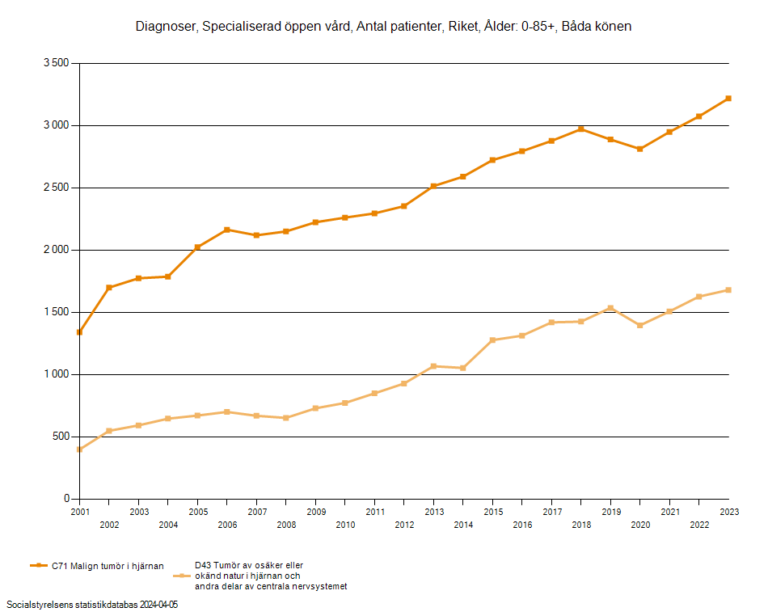The number of cases of malignant brain tumors, glioblastoma, has increased in Sweden among men over the past 20 years according to new data from the Swedish cancer registry. About twice as many men were diagnosed in 2022 compared to 2001. The increase has coincided with the growing use of mobile phones. Previous research has shown that mobile phone use increases the risk of brain tumors.
The graph below shows the number of cases of glioblastoma or astrocytoma grade 3-4, each year between 1990 and 2022 reported to the cancer registry at the Swedish National Board of Health and Welfare. Twice as many men were diagnosed in 2022 compared to in 2001. In 2022, 381 new cases among men and 188 new cases among women were registered. As shown in the diagram taken from the Swedish National Board of Health and Welfare’s statistics database below, which shows the number of new cases among men and women each year between 1990 and 2022, it is during the last 20 years that the increase has taken place.

Taking into account the age structure and population growth, so-called age-standardized incidence per 100,000 inhabitants, a trend of increasing incidence is also seen in the graph below, also from the Swedish National Board of Health and Welfare.

In the case of glioma grade 1-2, the benign grades of glioma, there appears to be no increase but rather a decrease. The number of new cases of grade 1-2 glioma reported per year is significantly lower compared with the malignant form. 70 cases among men and 61 cases among women were registered in 2022.
For all tumour types in the brain, brain nerves and meninges, 702 new cases were registered among men and 590 new cases among women in 2022 in Sweden. The number of cases per 100,000 inhabitants, age-standardised, has not increased since 1990. Malignant glioma accounted for over half of the registered brain tumors among men and just under a third of all among women.
In addition to malignant glioma, one of the most common diagnoses among men and women is meningioma, a brain tumor originating in the meninges. In 2022, 123 new cases were recorded among men and 241 cases among women n Sweden. Consequently meningioma represented 41% of all brain tumor diagnoses in women and 18% of all cases in men. Meningiomas are considered benign.
Malignant brain tumor cases also increasing in England
In 2018, a scientific paper was published which found that the number of cases of grade 3-4 gliomas was increasing significantly in England. Between 1995 and 2015, the number of glioblastoma cases per 100,000 population in England doubled, according to the article, which had analyzed national cancer statistics. The number of people affected by glioblastoma in England each year increased from 983 in 1995 to 2531 in 2015. The largest increase was seen for glioblastomas located in the areas that are most exposed to radiation while using mobile phones: the frontal and temporal lobes. At the same time, the number of cases of less severe forms of brain tumors decreased until 2007 and then remained stable. This represents a shift towards more severe forms of brain tumors.
The number of patients with brain tumors increasing
The Swedish National Board of Health and Welfare’s statistics on the number of patients treated in specialized outpatient care with a diagnosis of brain tumors are also ncreasing. Between 2002 and 2023 (2023 = preliminary data), the number of patients each year with malignant brain tumours has almost doubled, from 1 698 in 2002 to 3 217 in 2023. The graph below shows the number of patients with a diagnosis of malignant brain tumour or tumour of the central nervous system (men and women). In addition, there is an increase in patients with tumors of unclear type in the brain or central nervous system (men and women) from 548 in 2002 to 1,629 in 2023.

Below the number of patients per 100 000 inhabitants age standardised.

Large differences between Nordic countries
It has previously been discussed that the cancer registry is underreported because not all cases undergo pathological examination and thus do not receive the code required to be registered in the cancer registry. This may apply to inoperable brain tumors or brain tumors that are not operated for other reasons where the diagnosis was made by imaging. In 2017 Hardell and Carlberg concluded that there are indications of underreporting in the Swedish cancer registry. The large variation in the number of new brain tumor cases between the different Nordic countries is probably due to differences in reporting rates. As shown in the diagram taken from Nordcan/IARC below, a significantly lower incidence of the number of cases of brain tumours, age-standardized per 100,000 inhabitants, is seen in Sweden compared to the other Nordic countries throughout the period 1990 to 2021. In Denmark, a clearly increasing trend is seen, while Sweden reports a stable much lower incidence trend for all brain tumours.

Repeated studies show that mobile phone use increases the risk of brain tumors. On the other hand, repeated studies funded by telecom companies or conducted by researchers with ties to telecom companies also show no increased risk. The latest telecom-funded study was published in early March. You can read about it here.
A study from Taiwan (2023) reported a slight rise in the incidence and death rates of malignant brain tumors.







